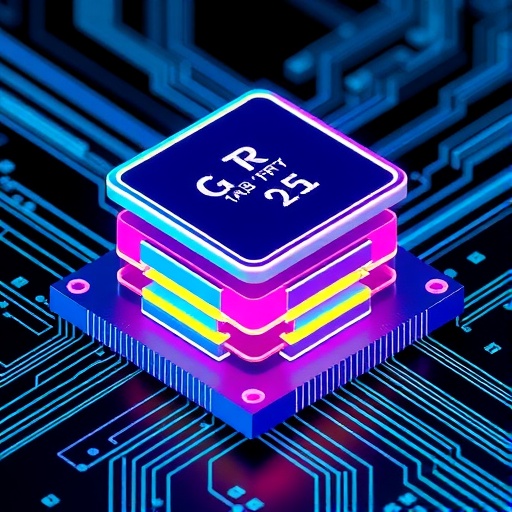In the search for faster and more efficient electronic devices, researchers are turning their attention to the innovative landscape of two-dimensional (2D) materials. These materials promise a transformative development in the field of electronics, particularly as a potential replacement for silicon in future technologies. Silicon, long the cornerstone of semiconductor technology, is reaching the limits of its scalability, creating an urgent need for alternatives that can withstand the relentless pace of technological advances. But as promising as 2D materials are, they present unique challenges in terms of effective gate stack engineering – critical to the performance of metal-oxide-semiconductor field-effect transistors (MOSFETs).
Integration of 2D materials into transistors is complicated by the lack of compatible high-k dielectrics, which are essential for optimal channel control. The properties of 2D materials, such as their high surface-to-volume ratio and exceptional electronic properties, offer significant advantages; However, they also require the development of new manufacturing processes that take into account their different physical and chemical properties. Researchers have begun studying the effectiveness of existing silicon-based gate stack technologies to evaluate how they can be adapted or redesigned to work harmoniously with 2D materials.
One of the most promising research avenues is ferroelectrically embedded gate stacks. These structures offer additional capabilities that could revolutionize the development of non-volatile memory technologies. By embedding ferroelectric materials into the gate stack, researchers can use their unique switching properties to develop devices that retain information even when turned off. Such innovations could further decouple memory from processing units and lead to new forms of logic-in-memory architectures that integrate storage and computation more seamlessly than ever before.
As the push for more efficient, low-power transistors increases, the need for advanced gate stack strategies becomes increasingly important. Unlike traditional semiconductors, 2D materials can enable operation with significantly lower power consumption due to their unique electrical properties. In particular, the high mobility in 2D materials means that transistors made from these substances can operate effectively at much lower voltages, reducing overall power consumption and heat generation.
However, achieving reliable performance of 2D transistors through effective gate stack technology is a multifaceted challenge. The performance metrics for each transistor must include not only current driving capabilities, but also emphasize the importance of subthreshold swing, short channel effects, and off-state leakage currents. Each of these factors plays a critical role in how well a transistor can perform, especially in the context of high-speed operations. Careful benchmarking against existing silicon technologies is essential to establish an evaluation framework and pave the way for identifying performance gaps that need to be addressed.
In addition to technical performance, user-focused aspects such as scalability and manufacturing feasibility pose critical challenges to the widespread adoption of 2D transistors. Refinement of existing manufacturing methods to support new materials is an arduous task that requires collaboration across multiple disciplines – from materials science to electrical engineering. Therefore, advances in gate stack design are not only a scientific but also a manufacturing challenge that requires innovative approaches that enable a shift from silicon-centric methods to those that support a new class of materials.
In addition to practical considerations, researchers are also concerned with the stability and reliability of materials over time. The interactions between 2D materials and their dielectric counterparts – ferroelectric or otherwise – must be carefully understood to ensure consistent performance over time. Addressing degradation and stability issues will be critical before these next-generation transistors can be considered as viable alternatives for commercial applications.
As research in 2D materials advances, the International Roadmap for Devices and Systems sets ambitious goals for the technology to meet. The commitment to solidifying industry benchmarks requires continuous reassessment of how experimental evidence translates into real-world performance. The potential for 2D materials in various applications, including mobile devices, wearable technology and even large-scale computing solutions, keeps researchers on the horizon of the possible.
The future of electronics may depend on the refinement and implementation of gate stack engineering strategies that can seamlessly integrate 2D materials. Future work in this area is expected to address not only technical obstacles, but also regulatory and economic issues that govern manufacturing processes. As we move toward a post-silicon world, the concerted effort to advance this research will undoubtedly culminate in a new era of high-performance, low-power electronic devices.
As we stand at this crucial threshold of technological development, the prospect of using 2D materials in transistor designs is generating a sense of excitement in the scientific community. Researchers are optimistic that integrating advanced gate stack technology with novel materials through continued research and innovation will redefine the landscape of electronic devices in ways previously only imagined in theoretical studies. It's a tantalizing journey into the future, where each breakthrough in gate stack technology not only advances the advancement of 2D materials, but also leads us to overcome the limitations of traditional silicon technologies.
In summary, despite numerous challenges, the potential benefits of 2D materials in electronics are breathtaking. The era of improved computing capabilities and radically improved energy efficiency is upon us. A future awaits you full of devices that surpass current technologies and leverage the unique properties of 2D materials – a future that will ultimately redefine the way we interact with technology every day.
Subject of research: Gate stack engineering for two-dimensional transistors
Article title: Gate stack engineering of two-dimensional transistors
Article references:
Kim YH, Lee D, Huh W et al. Gate stack engineering of two-dimensional transistors.
Nat Electron 8, 770–783 (2025). https://doi.org/10.1038/s41928-025-01448-5
Photo credits: AI generated
DOI: https://doi.org/10.1038/s41928-025-01448-5
Keywords: Two-dimensional materials, gate stack engineering, transistors, silicon technologies, ferroelectric materials, logic-in-memory, low-power electronics.
Tags: 2D materials in electronicsAdvances in transistor technologyAlternatives to silicon in semiconductorsChallenges of integrating 2D materialsElectronic properties of 2D materialsManufacturing processes for 2D transistorsFerroelectric gate stacks in electronicsGate stack technology in transistorsHigh-k dielectrics for 2D transistorsPerformance of MOSFETs with 2D materials, scaling limitations of silicon technology, transformative development in semiconductor technology
